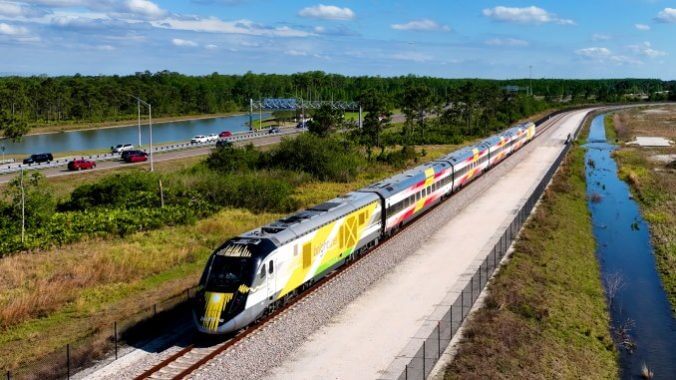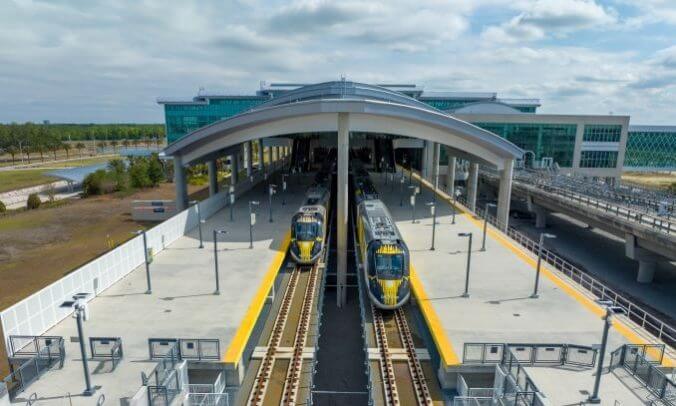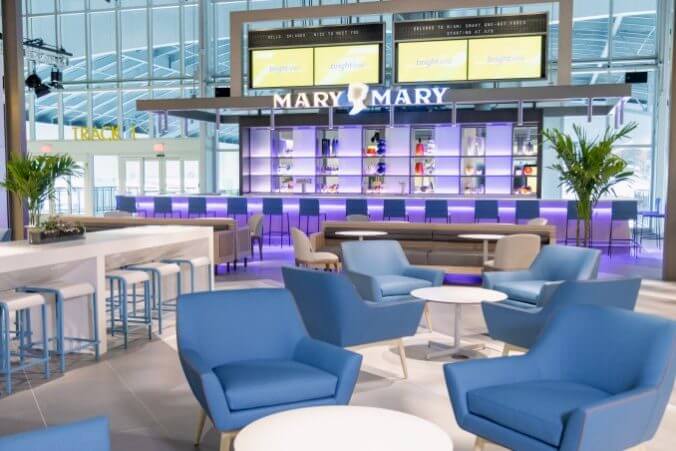Brightline Brings High Speed Rail to Florida
Photos courtesy of Brightline
When Brightline opened its Orlando train station at the Orlando International Airport last week, it came one step closer to connecting Central and South Florida with high speed rail. Starting this summer trains will run daily from Orlando International Airport to 6th Street in downtown Miami, topping out at 125 miles per hour, and passing through Brightline’s other stations at West Palm Beach, Boca Raton, Fort Lauderdale, and Aventura along the way. It’ll offer a simple, stress-free way to travel between two of America’s most popular tourist destinations, and also introduce America to the kind of high speed rail found in so many other countries around the world. And if you’re surprised that the first major high speed rail project in America would happen in Florida—a state with a, let’s say, very specific reputation—you shouldn’t be. Brightline is building on a history of rail travel in Florida that dates back to the 19th century.
“This is the first privately owned intercity passenger rail in the United States since Henry Flagler did it in, like, 1895,” Patrick Goddard, the President of Brightline, points out. Flagler’s Florida East Coast Railway was crucial to developing the state in the 1890s and 1900s, and Brightline now owns its freight corridor from Jacksonville to Miami, using tracks from the FEC for its line from West Palm Beach to Miami. At one point used for both passenger and freight travel, this line long ago became freight only; in a sense Brightline is reclaiming it for its original purpose. “When we passed the Federal Highway Act in the 1950s I don’t think we anticipated that 70 years later all the highways would be congested,” Goddard notes. “By doing that we gave up all the railroads to the freight companies. We’ve got the best freight infrastructure in probably the whole world, but we’ve got the worst passenger infrastructure as a result. So I think this is a step in the right direction.”
By punting passenger rail in favor of highways America has basically raised a country full of people who don’t even consider rail as a viable transportation option outside of local transit systems. We love our planes and automobiles but don’t have time for trains. Anybody who’s traveled through Europe or Asia, though, has probably seen how convenient and comfortable high speed rail can be. It’s faster than driving, doesn’t have many of the hassles associated with flying, and is much better for the environment and for urban planning than cars. And yet the U.S. is still reluctant to build high speed rail. Goddard laments how “the U.S. is about 50 years behind Europe and Asia in terms of intercity passenger rail,” and changing those attitudes is a major part of Brightline’s mission.
“It’s sort of embarrassing, to be honest,” he says. “But this is a golden opportunity. There’s never been a better moment in time to start thinking about intercity passenger rail in the United States, and what we’re doing in Florida is laying a blueprint for the rest of the country on how this can actually be done. And we’re doing it with private dollars.”

The first thing you notice when you approach a Brightline station is its signature color. Splashes of yellow can be found throughout, from the ticket kiosks, to the guest services desk, to accent lines running through the carpet. Across the board, from the trains to the stations, the Brightline design aesthetic is sleek, upscale, and bright, with big windows letting the sun in and a tasteful, minimalist color scheme punctuated by those bold bursts of yellow. The second thing you notice, if your sinuses aren’t clogged, is Brightline’s signature scent—a light citrus note that feels clean, refreshing, and very Floridian. That scent will follow you throughout your Brightline journey, from the station to the train to the cold towel the attendant gives you when you take your seat.
-

-

-

-

-

-

-

-

-

-

-

-

-

-

-

-

-

-

-

-

-

-

-

-

-

-

-

-

-

-

-

-

-

-

-

-

-

-

-

-









































